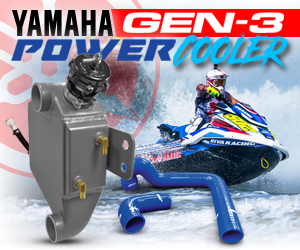For many, all that matters is horsepower. Unfortunately, while horsepower numbers can definitely be alluring, understanding how hull design plays into the application of horsepower is all the more important. Sea-Doo’s offers its stellar 1630 ACE 300 engine in two platforms: the ST3 (RXT-X, GTX) and the T3 (RXP-X). These two platforms not only differ in hull shape and intended design, but vary vastly in accessories, features and overall use. And since so many are unfamiliar with these key differences, The Watercraft Journal partnered up again with Sea-Doo Media Relations guru Tim McKercher to spell these differences out in detail.
So let’s start with what these two machines have in common: 300 horsepower. That’s right, both the top-of-the-performance-line RXT-X 300 and buoy-course-killing RXP-X 300 share the same supercharged-and-intercooled 1630 ACE 300. Building upon the previous Rotax 1503, the ACE 300 is a 1,630cc 3-cylinder four-stroke producing a true 300 brake horsepower. The sleeveless block features plasma coated-cylinders that not only cut engine weight, but improve surface durability and heat transference, all while minimizing friction. Redesigned pistons are 20 grams lighter than previous Rotax 1503’s and feature longer, coated skirts.
While the new 1630.5cc features the same 100mm bore of the 1503, it has an increased 69.2mm stroke (over the previous 63.4mm), providing 9-percent more displacement, and subsequently, 15-percent more power. And thus, Sea-Doo had itself a winning engine package. But what to put it into? First on that list was its racy two-seater musclecraft, the RXP-X. Redesigned for 2012, the RXP-X rode on a hull that dimensionally matched the GTI, as the two shared the same deck. Below the bondline, the RXP-X hull featured a prominent keel and soft (or rounded) outer chines that permit the craft to roll heavily into a corner. The keel is flanked by two lifting strakes for less friction.
The natural tendency for the RXP-X is to snap off lightning quick hairpin turns, similar to how McKercher in the video attached below, compares to a sportbike. The RXP-X’s intended design is for super-aggressive buoy course racing, so few are surprised at how responsive it is to steering input while at speed. While some might call it “unforgiving” the performance enthusiast will cheer it on. It all depends on your riding style. Conversely, the larger, full-sized 3-seater RXT-X 300 rides on Sea-Doo’s ST3 hull, introduced for 2018. The hull itself is a modified-V shape, featuring a sharper keel at the bow, gradually softening as it flows aft.
Directly in opposition of the RXP-X, the ST3 hull has prominently sharp chines, giving the craft far superior stability at lower speeds but slightly less intuitive handling when under throttle. The sides flanking the dihedral keel are surprisingly smooth, giving the ST3 a larger wetted surface than the T3 hull or the previous S3 hull shape. While this ought to produce more drag, the ST3 is also marked with a quartet of lifting strakes reducing drag and helping the craft rise to plane far quicker than previous full-sized Sea-Doo runabouts. This design has helped give the RXT-X 300 one of the fastest idle-to-60mph speeds in the industry (we know because we proved it here and here).
All that being said, the RXT-X 300 (and other ST3-based runabouts) offer a king’s ransom of features and accessories not available on the purpose-built RXP-X 300; namely, Sea-Doo’s center storage system, the absolutely killer BRP Premium Audio System, and the LinQ accessory platform, permitting the attachment of the Retractable Ski Pylon, LinQ cooler, fuel caddy or extra storage bag. Equally, all ST3-based machines offer tilt steering, deep footwells, and a huge swim platform to enjoy. So while engine performance and top speed are near equal between the two machines, how the RXP-X 300 and RXT-X 300 employ that power is very, very different.











Uh Tim … it’s “RPM” and not “RPM’s.”
Also, when referencing the RXP-X to a Charger, it ain’t so. It’s more like the RXT-X as a Charger is in no way a “sports car” to be thrown in with with the likes of a Porsche. But lastly, and most importantly, this was the best “explanation” video out there on these two models. Thanks.